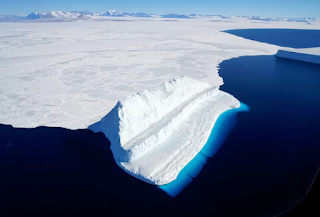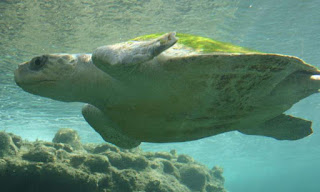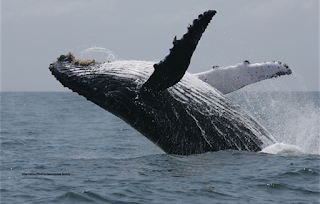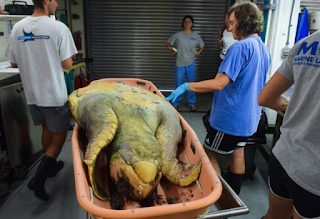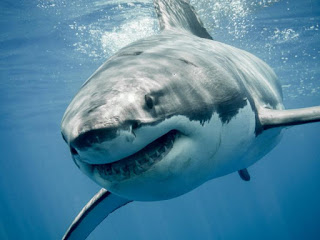“Advances in Atmospheric Sciences” publishes data showing 2018 hottest record, Antarctica cleaving gigatons of ice, CITES unveil proposals for 2019 conference, DOW moves to fight plastic waste, Florida red tide devastates sea turtle population, and much more…
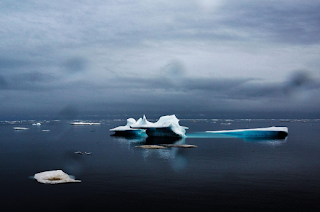 Earth’s oceans are warmer now than at any point since humans started systematically tracking their temperatures, according to research published on January 16 in Advances in Atmospheric Sciences. The oceans have sopped up more than 90 percent of the heat trapped by human-emitted greenhouse gases, slowing the warming of the atmosphere—but causing many other unwelcome changes to the planet’s climate. Even a slightly warmer ocean can have dramatic impacts. Other new research shows that warmer oceans make waves stronger. Warmer waters fuel stronger storms, increasing the damage that hurricanes and tropical storms inflict. The added warmth hurts coral habitats and stresses fisheries.
Earth’s oceans are warmer now than at any point since humans started systematically tracking their temperatures, according to research published on January 16 in Advances in Atmospheric Sciences. The oceans have sopped up more than 90 percent of the heat trapped by human-emitted greenhouse gases, slowing the warming of the atmosphere—but causing many other unwelcome changes to the planet’s climate. Even a slightly warmer ocean can have dramatic impacts. Other new research shows that warmer oceans make waves stronger. Warmer waters fuel stronger storms, increasing the damage that hurricanes and tropical storms inflict. The added warmth hurts coral habitats and stresses fisheries. Read more from “National Geographic”
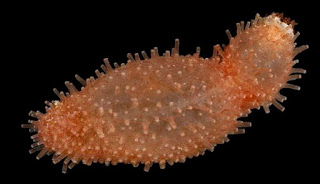 CITES CoP meetings occur roughly every three years and changes to trade rules, through amendments to the Convention’s Appendices, can have profound conservation implications for affected species. The listing of a species in Appendix I effectively prevents all commercial international trade, while those listed in Appendix II can be traded under special permit conditions. Here are the proposals CITES unveils to be reviewed at CoP18 in Sri Lanka this year.
CITES CoP meetings occur roughly every three years and changes to trade rules, through amendments to the Convention’s Appendices, can have profound conservation implications for affected species. The listing of a species in Appendix I effectively prevents all commercial international trade, while those listed in Appendix II can be traded under special permit conditions. Here are the proposals CITES unveils to be reviewed at CoP18 in Sri Lanka this year.
———————————————–
Antarctica is hurling its guts into the ocean. And it’s happening six times faster now than it was even four decades ago. The southern, frozen continent lost an average of 252 gigatons of ice a year to the sea between 2009 and 2017. Between 1979 and 1990, it lost an average of just 40 gigatons per year. That means that ice loss on Antarctica has accelerated by 6.3 times in just four decades, according to new research published yesterday (Jan. 14) in the journal Proceedings of the National Academy of Sciences.
———————————————–
Dow Chemical Co. is forming a global alliance with 30 other companies to focus on reducing plastic waste that ends up in the oceans and the environment. The global nonprofit called the Alliance to End Plastic Waste includes companies like Dow, Shell, Exxon Mobil Corp. along with Proctor & Gamble Co., Chevron Corp. and others. They plan to finance the work with $1 billion and a goal of raising $1.5 billion over the next five years.
5. Desalination Pours more Toxic Brine into the Ocean than Previously Thought
7. New Orca Calf Seen Among Puget Sound’s Critically Endangered Killer Whales
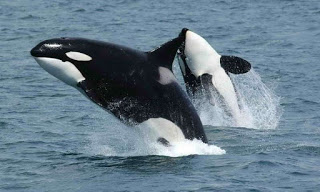 A new calf has been born to the critically endangered southern resident killer whales, researchers confirmed. The calf was born to L77, said Ken Balcomb, founding director of the Center for Whale Research. He confirmed the birth in a text to The Seattle Times Friday. He estimated the calf is several weeks old. Center staff first saw the calf Friday morning at the eastern end of the Strait of Juan de Fuca.“It’s great news,” Balcomb said, adding the calf looks healthy. It is the first known birth to the southern residents since Tahlequah, or J35, gave birth to a calf in July that lived only a half-hour.
A new calf has been born to the critically endangered southern resident killer whales, researchers confirmed. The calf was born to L77, said Ken Balcomb, founding director of the Center for Whale Research. He confirmed the birth in a text to The Seattle Times Friday. He estimated the calf is several weeks old. Center staff first saw the calf Friday morning at the eastern end of the Strait of Juan de Fuca.“It’s great news,” Balcomb said, adding the calf looks healthy. It is the first known birth to the southern residents since Tahlequah, or J35, gave birth to a calf in July that lived only a half-hour.
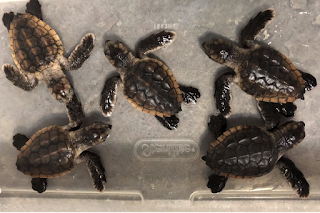 Last summer, tourists from Kentucky sparked Internet outrage when they admittedly took six baby sea turtles from a Tybee Island beach and placed the threatened animals in a hotel trash can. A housekeeper at the Admiral’s Inn found the loggerhead sea turtle hatchlings in a water-filled bin and then contacted police on July 24, according to a Tybee Island police report. Five months later, Danielle Tosh, 24, and Michael House, 42, have been fined $930 each in connection with the incident, according to Barry Paschal, public affairs officer at the Office of the U.S. Attorney for the Southern District of Georgia.
Last summer, tourists from Kentucky sparked Internet outrage when they admittedly took six baby sea turtles from a Tybee Island beach and placed the threatened animals in a hotel trash can. A housekeeper at the Admiral’s Inn found the loggerhead sea turtle hatchlings in a water-filled bin and then contacted police on July 24, according to a Tybee Island police report. Five months later, Danielle Tosh, 24, and Michael House, 42, have been fined $930 each in connection with the incident, according to Barry Paschal, public affairs officer at the Office of the U.S. Attorney for the Southern District of Georgia.9. Marine mammals and sea turtles recovering after Endangered Species Act protection
More than three-quarters of marine mammal and sea turtle populations have significantly increased after listing of the U.S. Endangered Species Act (ESA), according to a study published January 16 in the open-access journal PLOS ONE by Abel Valdivia of the Center for Biological Diversity in California, and colleagues. The recovered animals were those that were protected for 20 years or more. The findings suggest that conservation measures such as tailored species management and fishery regulations, in addition to other national and international measures, appear to have been largely successful in promoting species recovery, leading to the delisting of some species and to increases in most populations.
New research suggests that humpback whale populations in the Atlantic and Indian Oceans are picking up musical ideas from one another, and incorporating the new phrases and themes into their songs. According to the study, published November 28, 2018, in the peer-reviewed journal Royal Society Open Science, humpback whale populations in different Southern Hemisphere ocean basins (the South Atlantic and Indian Oceans) sing similar song types, but the amount of similarity differs across years. This suggests that males from these two populations come into contact at some point in the year to hear and learn songs from each other.
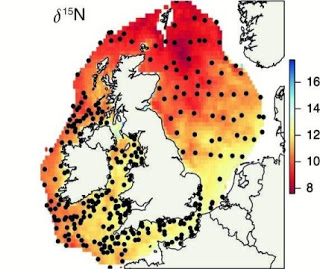 Researchers have developed a map of chemicals found in jellyfish caught across 1 million square kilometers of UK waters. The same chemicals are found in other marine animals such as birds and fish. These findings can support conservation efforts by helping track an animals movements and also be used as a tool to detect food fraud by identifying where seafood products were sourced from.
Researchers have developed a map of chemicals found in jellyfish caught across 1 million square kilometers of UK waters. The same chemicals are found in other marine animals such as birds and fish. These findings can support conservation efforts by helping track an animals movements and also be used as a tool to detect food fraud by identifying where seafood products were sourced from.The Key West City Commission on Tuesday unanimously voted to ban the sale of sunscreens that contain two ingredients — oxybenzone and octinoxate — that a growing body of scientific evidence says harm coral reefs.“This ordinance is just one other thing we can do to help improve and protect our water quality,” said Mill McCleary, of the nonprofit environmental protection group Reef Relief. The measure, which passed 7-0, isn’t law yet, though. The commission must review it a second time and pass the measure again before it would become law. The second vote is scheduled for Feb. 5
A Florida red tide outbreak close to 16 months old has killed more sea turtles than any previous single red tide event on record, and manatee deaths are not far behind. The Florida Fish and Wildlife Conservation Commission attributed 589 sea turtles and 213 manatee deaths to this episode of red tide, which began in late 2017. It had killed 127 bottlenose dolphins as of Dec. 20, leading the National Oceanic and Atmospheric Administration to declare an unusual mortality event.
Read more “The Columbus Dispatch”
14. Deep Blue, The Massive, 20ft-Long Great White Shark Thought To Be Biggest On Record, Spotted Off Hawaii Coast
A great white shark, believed to be one of the biggest on record, has been spotted off the coast of Hawaii. Divers found the huge creature, named Deep Blue, as she fed on a dead sperm whale, around nine miles from the coast off the Hawaiian island of Oahu, KHON2 reported. Dr. Melanie Hutchinson, a shark expert at the University of Hawaii, told KHON2 the animal is thought to measure between 15 to 21 feet in length.

